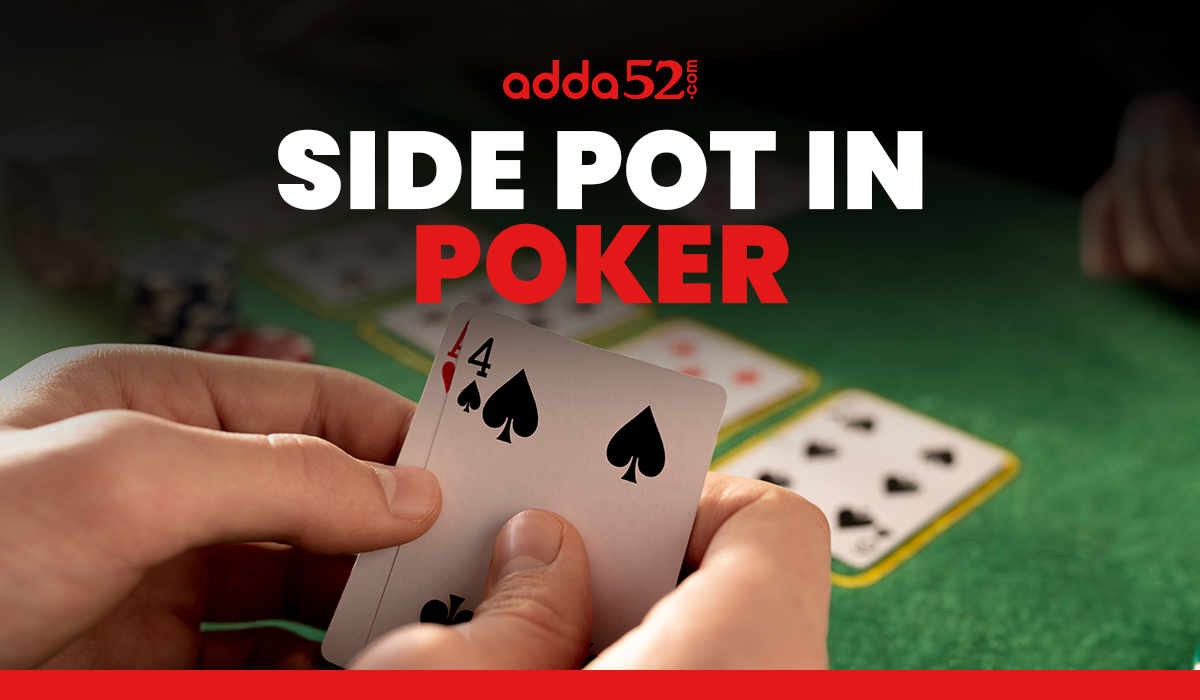Side Pot In Poker
Introduction
In poker, a side pot becomes relevant when a player goes all-in with an insufficient number of chips for the upcoming bet. This results in an additional pot, allowing players with a surplus of chips to continue wagering.
In this blog, we will learn the rules governing side pot creation, the order of showdown, and the fair distribution of winnings. We’ll also explore various side pot scenarios, from basic situations to complex multiple all-ins.
By the end of this blog, you'll possess a comprehensive understanding of side pots, enhancing your strategy and elevating your poker game.
What is Side Pot in Poker?
In poker, a side pot emerges when a player goes all-in with fewer chips than needed for the next bet. This creates an extra pot for players with more chips to keep betting.
The main pot is for the all-in player, while the side pot is for others still in the game. If the all-in player wins, they take the main pot, and the side pot goes to the one with the best hand among the rest.
Side pots spice up the game, making poker more interesting as players juggle multiple pots and decisions at the table.
How Side Pots Are Formed?
While playing poker, you may have noticed two separate virtual piles of chips in the middle of the table. You may have also seen an all-in situation where one player clearly wins the hand, but two (or more) players receive chips after the showdown. This is possible with “Side Pots”.
In Texas Holdem, players can continue playing even if they run out of chips, but they can only risk what's in front of them.
If a player goes all-in but others continue betting, a separate pot is formed for those remaining players. All-ins are relatively common in No-Limit Texas Holdem games.
This is also frequent in poker tournaments, where a small stack goes all-in, and remaining larger stacks might build up for a side pot bigger than the main pot.
To calculate side pots, consider an example with four players.
Side pot 1:
- Player 1 goes all-in with INR 100
- everyone matches the bet.
- Player 1's pot (max amount Player 1 can win) - INR 400
- Other players compete for both individual and collective pots.
Side pot 2:
- Later, Player 2 faces an INR 600 bet
- Player 2 go all-in with INR 200
- Player 2's pot - INR 600 (The remaining 2 players each contribute INR 200)
The game continues as usual from this point onward. At the showdown, the pots are awarded in reverse order. The last two players reveal their cards, and the winner claims the third pot. Following this, Player 2 reveals his hand, and the winner takes "Player 2's Pot." Finally, Player 1 reveals his hand against all three opponents, and the winner claims "Player 1's Pot."
Rules of Side Pots
- Side Pot Creation: A side pot comes into play when one or more players go all-in, but others still have chips to bet.
- Initial Bet: Players contribute to the main pot, betting only what the all-in player can match.
- Additional Betting: Players with remaining chips can continue betting in the side pot.
- Showdown: At the end, if there are multiple pots, reveal hands for each pot separately.
- Winning the Main Pot: The player with the best hand overall wins the main pot.
- Winning the Side Pot: The player with the best hand among those who contributed to the side pot wins it.
- Multiple Side Pots: If more than one player goes all-in, multiple side pots can be created.
- Order of Showdown: Main pot is shown first, followed by each subsequent side pot.
- Chips Allocation: Players can win multiple pots, but a player must have contributed to a pot to win it.
- Remaining Chips: If a player wins the main pot, but not the side pot, they get their remaining chips back.
- Fair Distribution: Side pots are distributed in order, starting with the player who won the earliest pot.
- Elimination: If a player cannot cover a bet in any pot, they are only eligible to win the pots they contributed to.
Side Pot Scenarios
Basic Side Pot Scenario:
- Situation: Player A bets INR 50, Player B calls, and Player C raises to INR 100.
- Side Pot: Player A and Player B are in the main pot for INR 50 each. Player C has created a side pot of INR 50 (INR 25 from A and INR 25 from B) with Player C.
All-In Side Pot Scenario:
- Situation: Player A goes all-in with INR 75, Player B calls with INR 50, and Player C raises to INR 100.
- Side Pot: Players A and B are in the main pot for INR 50 each. Players C and A are in a side pot for the remaining INR 25 from A's all-in.
Multiple All-Ins Scenario:
- Situation: Player A goes all-in with INR 75, Player B goes all-in with INR 100, and Player C raises to INR 150.
- Side Pots:
- Main Pot: INR 75 from A, INR 75 from B.
- Side Pot 1: INR 25 from A, INR 25 from B, and INR 50 from C.
- Side Pot 2: Remaining INR 25 from B and INR 100 from C.
Split Side Pot Scenario:
- Situation: Player A bets INR 50, Player B calls, and Player C goes all-in with INR 100. Player A calls the additional INR 50.
- Side Pot: Players A and B are in the main pot for INR 50 each. Players C and A are in a side pot for INR 100. If Player C wins, they take the INR 100 side pot, and if Player A wins, they take both the main pot and the INR 100 side pot.
Three-Player All-In Scenario:
- Situation: Player A goes all-in with INR 50, Player B goes all-in with INR 75, and Player C goes all-in with INR 100.
- Side Pots:
- Main Pot: INR 50 from A, INR 50 from B, and INR 50 from C.
- Side Pot 1: INR 25 from B and INR 25 from C.
- Side Pot 2: Remaining INR 50 from C.
These scenarios outline different situations where side pots can occur in poker, with varying complexities based on player actions and bet sizes.
Calculating Side Pots
Calculating side pots in poker is a crucial skill when multiple players go all in with different chip stacks. Let's break it down with an example involving three players: A, B, and C.
- Suppose Player A has INR 25, B has INR 50, and C has INR 100.
- All players go all-in, and based on the smallest stack (Player A's INR 25), the main pot is created with a total of INR 75 (INR 25 from each player). This INR 75 is what Player A can potentially win in the hand.
- Now, Player B has INR 25 left after contributing to the main pot.
- Player C, with a larger stack, is only required to cover the additional INR 25 from Player B.
- The "side pot" is formed, exclusively contested between Players B and C, totalling INR 50 (INR 25 from each player).
- Player C, having covered Player B's bet, immediately gets back his unmatchable INR 50.
- At the showdown, if A has the best hand, he wins the main INR 75 pot. If B or C has a better hand, they take both the main and side pots.
Importantly, only players contributing to a specific side pot are eligible to win that particular pot, ensuring a fair distribution of winnings in multi-way all-in situations.
Frequently Asked Questions
What is the logic of the side pot in poker?
The side pot in poker serves to accommodate additional bets made by players with higher chip counts than the initial player, allowing multiple layers of betting in a single hand.
What is a side bet in poker?
A side bet in poker is an additional wager made alongside the main pot, often involving separate conditions or outcomes, providing players with an extra avenue for strategic play and potential winnings.
How do you distribute a side pot?
Side pots are distributed in poker based on chip contributions from players involved; each pot is awarded to the best hand among those contributing to that specific pot.
Can you still win a side pot if you fold?
Yes, in poker, you can still win a side pot even if you fold from the main hand, as side pots are independent of the primary hand and involve separate betting scenarios.
Conclusion
In conclusion, a side pot in poker is like an extra pot that forms when players go all-in with varying chip amounts. It adds excitement and strategy to the game, especially in Texas Hold'em and tournaments. Understanding how side pots work is crucial, as they determine who gets what at the end. The rules ensure fairness, with players winning only the pots in which they've contributed. The outcome hinges on revealing the best hand for each pot, making side pots an intriguing element that enhances the excitement and strategic depth of poker games.

